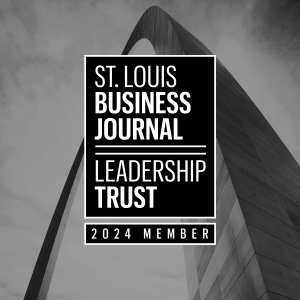Melissa Lackey Discusses Four Steps for After the Sustainability Report
Companies view their work as finished after the sustainability report, but it's one part of the journey. These 4 steps maintain sustainability reporting momentum.
 Standing Partnership Group President Melissa Lackey is a member of the St. Louis Business Journal Leadership Trust, an invitation-only network of business leaders and executives who share their successful business knowledge and insights with the Journal’s readers. In June, Melissa was featured in an article on four steps for companies to follow to maintain momentum after releasing a sustainability report. The article was first published on the Business Journals website here.
Standing Partnership Group President Melissa Lackey is a member of the St. Louis Business Journal Leadership Trust, an invitation-only network of business leaders and executives who share their successful business knowledge and insights with the Journal’s readers. In June, Melissa was featured in an article on four steps for companies to follow to maintain momentum after releasing a sustainability report. The article was first published on the Business Journals website here.
The following is a reprint, courtesy of the St. Louis Business Journal Leadership Trust.
As the sustainability reporting cycle comes to a close, many companies that released a report view their work as done until the next year. In reality, the report is just one step in the sustainability communication journey. According to consulting agency Standing Partnership, companies that communicate their sustainability investments in a way that meets stakeholder interests throughout the year are better positioned for sustainable growth.
“Public companies have experienced the greatest demand for sustainability-related reporting; however, even private companies are now feeling the pressure from various stakeholders to set and communicate sustainability goals,” said Melissa Lackey, owner, president and CEO of Standing Partnership. “If you’ve done a report, this off-season might be the right time to dive a little deeper to reassess your stakeholders’ needs, motivations and concerns.”
People are more ethically and socially motivated in their decisions than ever, Lackey explained. They want to know that they are purchasing from responsible companies that embrace environmental stewardship and treat their employees with dignity. To deliver on these consumer expectations, companies need to identify and align around the highest priorities from a business sustainability perspective, from an employee perspective and from external stakeholders’ perspectives.
Standing Partnership’s vice president Andrea Shea, who leads sustainability for the organization, elaborated on what it means to dig deeper for your stakeholders. “Being responsible to your investors means financial stewardship and risk management, but a responsible business also means understanding and meeting the needs of the people you employ, the community and environment in which you operate, and the customers you serve,” she said. “Your sustainability communications need to cover all of that — but that can also result in a long unwieldy document. The key to finding the right balance is to understand what each stakeholder wants to know and how to best communicate it with them. Then use your downtime between reports to create these engagement opportunities.”
To help navigate these demands, Lackey and her team at Standing Partnership recommend companies take the following four steps to maintain momentum after releasing a sustainability report.
1. Revisit your materiality assessment
After completing your sustainability report, take a step back from it. Is the data presented still the most relevant to your stakeholders? Today, stakeholders are overwhelmed by the massive amounts of data contained in an average sustainability report. A materiality assessment is a methodical process that is used to understand what is important to your stakeholders, both external and internal, and what your organization is well-positioned to impact. You should consider the communities you operate in, their governments and elected officials, regulators, prospective employees and partners, customers, investors and more.
“This is best accomplished via interviews and surveys and should be done every three to four years. You gather stakeholders’ input and determine what is most useful to them to make informed decisions about your business,” said Shea. “That knowledge not only helps you prioritize what to report and who to report it to, but also provides direction for what your company should focus on operationally to improve your own performance.”
2. Submit to ratings surveys
To benchmark your company’s sustainability performance against industry trends., you may want to consider submitting your sustainability report to independent ratings agency surveys. There are a litany of rating agencies you can submit to, including CDP, the Dow Jones Corporate Sustainability Assessment (CSA) or Morgan Stanley Capital International (MSCI). To determine which survey to enter, ask your investors first which ratings they value. Note that some stakeholder surveys are invite-only.
In addition, when companies want insights into the sustainability of their supply chains, they may ask you to complete a custom survey, or use an independent rating agency like EcoVadis, to compare the suppliers’ sustainability performance metrics. If you opt to do a comprehensive stakeholder survey like EcoVadis on your own, you will be better prepared to respond when customers ask you for information. Ratings by independent third parties not only inform operational changes within your company to advance sustainability goals but also build credibility and transparency with stakeholders.
3. Consider additional transparency reports
Sometimes, investors, other stakeholders or even a ratings agency will flag topics they see in the news or within industry discussions around a company or product. If this happens, your team could consider additional steps to explore that topic. You may find it’s something you are already managing through your stewardship processes, but did not explain at depth in your annual sustainability report. Sometimes, this spurs a new, topic-specific report where you can provide additional context which helps answer stakeholder questions. Refer back to your materiality assessment if you’re unsure how your individual stakeholders are affected by the issue and what they would like to know about it.
Lackey described an example of what this might look like: “A chemical manufacturer that deals with certain compounds may be flagged by a rating agency. What this tells the company is that there needs to be more education, more transparency and more communication on stewardship activities regarding those chemicals. A more detailed report can answer questions and, often, remove the red flag while improving the company’s rating score. “Tackle these specialty reports in the summer or fall, when the sustainability reporting team has more capacity to dive deeper,” said Lackey.
4. Create a culture of sustainability
After investing considerable time and energy into your sustainability report, plan how to best share it with your employees, customers and stakeholders to realize its full value. If this is your first reporting cycle, consider this an opportunity to share your sustainability strategy internally. Educating your employees about what sustainability means at your company, why you are investing in sustainability, and how to support the sustainability goals is a great way to enrich your company’s culture. Additionally, ensure that your recruitment strategy references sustainability to prospective employees, since many job seekers evaluate employers based on values alignment.
“I think the other piece is arming your sales team to talk about the work done to be a sustainable business, because customers really care about this. I’m starting to see a lot of big companies advertising their responsible business practices, leading with sustainability messaging, and what they actually produce comes secondary. This is another powerful way to activate sustainability,” said Lackey.
When it comes to communicating sustainability, Shea focuses on progress over perfection. “Once you have the first report under your belt, each year is another opportunity to evaluate first, what else you should be reporting, and second, how you are sharing it. This evolution is quintessential to the sustainability journey, and will help ensure that you are sharing that journey in an authentic, transparent and appropriate way with the stakeholders that matter most.”
Featured Insight
Materiality Assessment: Make Your Next Sustainability Report More Targeted and Impactful
While companies talk about being on a “sustainability journey,” sustainability reporting itself has also had quite the evolution. What started with social-focused impact reports transformed into massive reporting disclosures. Unfortunately,…

